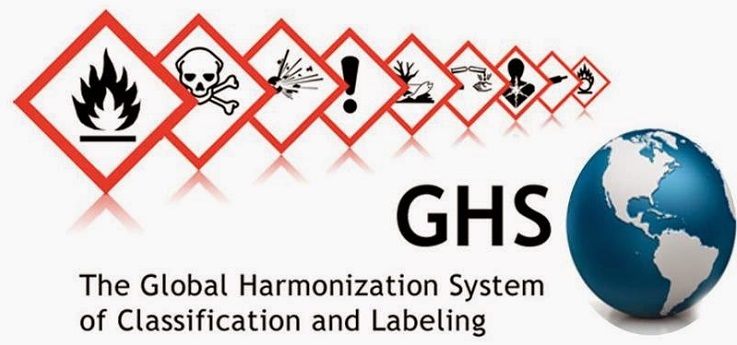
Hazard Communication Standard - HAZCOM (GHS)
The Hazard Communication Standard's purpose is to ensure that the hazards of all chemicals used in the workplace are evaluated, and that information concerning their hazards is transmitted to employers and employees.
The HazCom - Right to Understand (GHS) program ensures that employees who handle or are potentially exposed to chemicals are properly trained to identify the hazards of the chemicals in the workplace, and the precautions to follow to work safely with that chemical. It also provides details about how chemical containers and secondary containers must be properly labeled and marked with the chemical name, signal word, and hazards.
This page is designed to provide every SNC employee access to the chemical information contained in safety data sheets (SDSs), please see the right sidebar. This online resource will enable employees to locate sections that provide hazard identification, safe handling, and storage procedures. This page also contains links to supporting documents to the SNC HazCom (GHS) program, please select on the links below Learn More...
The Occupational Safety & Health Administration revised the Hazard Communication Standard on May 20, 2024, to bring it inline with the international Globally Harmonized System of Classification & Labeling of Chemicals 7th edition. Updates take effect on July 19, 2024. The United Nations made revisions in July of 2023 and published the (GHS Rev.10).
You must learn to identify the hazards of chemicals that you work with and the precautions to take to work safely with that chemical before opening the container and using any chemical.
The classification of chemical hazards and the standard format of chemical labels and safety data sheets will provide you with the details you need to follow to work safely with chemicals. The two groups of chemicals that can cause damage or injury if incorrectly handled during use or storage are health-hazardous chemicals and physically-hazardous chemicals.
Health-hazardous chemicals include those which are carcinogens, toxic or highly toxic agents, reproductive toxins, irritants, corrosives, sensitizers, hepatotoxins, nephrotoxins, neurotoxins, hematopoietic system agents and agents which damage the lungs, skin, eyes or mucous membranes.
Physically-hazardous chemicals refer to those in which there is scientifically valid evidence that it is a combustible liquid, a compressed gas, explosive, flammable, an organic peroxide, an oxidizer pyrophoric or unstable or water-reactive.
To learn more about chemical hazards please read Safety in Academic Chemistry Laboratories 8th Edition - chapter 3 Guide to Chemical Hazards - pages 26-45.
Exposures for all substances should be minimized; during work with substances which present special hazards, special precautions should be taken. Any toxic mixture should be considered more toxic than its most toxic component. Substances of unknown toxicity should be considered toxic.
Always read the label and check the Safety Data Sheet (SDS) information before working with a chemical.
The transmittal of this information will be accomplished by means of comprehensive hazard communication program; which includes container labeling that must now include one or more of nine pictograms, and also include a signal word (Danger or Warning), hazard statements, precautionary statements, safety data sheets, chemical lists, international chemical safety cards and employee training that also covers secondary container labeling.
Example of container labeling (PDF)
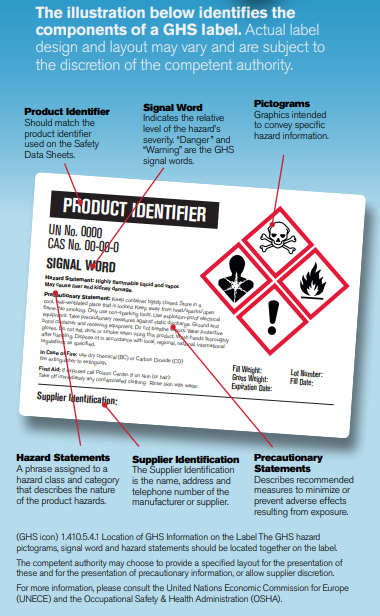
Example of a secondary container label -
used for lab preps when setting out smaller containers.
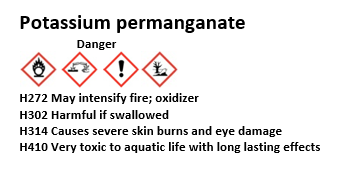
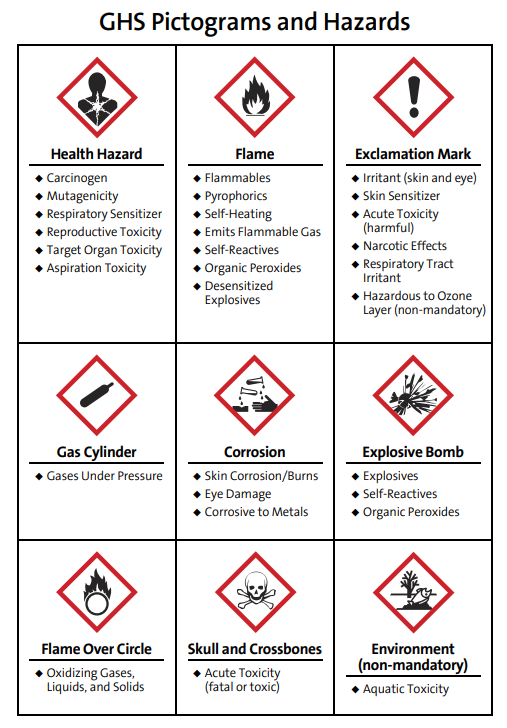
Example of Safety Data Sheet for Acetone (Full PDF)
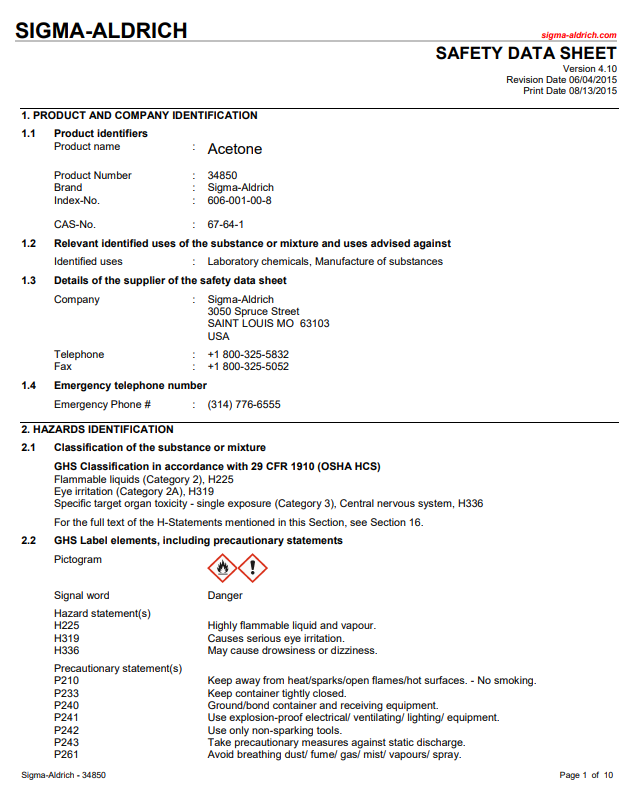
Contents of the Standardized Safety Data Sheet and Section
- Section 1, Identification: Find the chemical manufacturer's or importer's name, address and an emergency phone number.
- Section 2, Hazard Identification: GHS classification, signal word, hazard statement, symbol and precautionary statement.
- Section 3, Composition/Information on Ingredients: Find the chemical identity and concentration or concentration ranges for all ingredients 1% or more for health hazards, and 0.1 or greater, if carcinogens CAS number for a hazardous chemical.
- Section 4, First Aid: Description of necessary measures, subdivided according to different routes of exposure (e.g., inhalation, skin and eye contact, and indigestion), most important symptoms/effects, acute and delayed. Indication of immediate medical attention and special treatment if needed, if necessary.
- Section 5, Fire-fighting Measures [how to fight a fire involving the chemical, suitable and unsuitable extinguishing media, nature of any hazardous combustion products]
- Section 6, Accidental Release Measures [personal precautions, protective equipment, how to handling a spill involving the chemical, emergency procedures, environmental precautions]
- Section 7, Handling and Storage [precautions for safe handling and storage procedures, including any incompatibilities]
- Section 8, Exposure Control/Personal Protection [permissible exposure limits, information about necessary engineering controls]
- Section 9, Physical and Chemical Properties [chemical's appearance, pH, evaporation rate, flammability, flash point, solubility, vapor density]
- Section 10, Stability and Reactivity [learn about stability and other materials that are incompatible with a chemical, possibly causing a hazardous reaction if the materials are not segregated, conditions to avoid, hazardous decomposition products]
- Section 11, Toxicological Information [find routes of exposure and symptoms of exposure, immediate, delayed, and chronic effects]
- Section 12, Ecological Information [ecotoxicity and bioaccumulative potential, persistence and degradability]
- Section 13, Disposal Considerations [information about safe disposal of waste chemicals and contaminated packaging]
- Section 14, Transportation Information [UN number and proper shipping name, required for transporting chemicals]
- Section 15, Regulatory Information [list of safety, health, and environmental regulations that apply to the product]
- Section 16, Other Information [information on preparation and revision of the SDS]
Globally Harmonized System (GHS) of Classification and Labeling of Chemicals
The Globally Harmonized System (GHS) of Classification and Labeling of Chemicals is a worldwide initiative to promote standard criteria for classifying chemicals according to their health, physical and environmental hazards.
The GHS was developed by international mandate to benefit countries, international organizations and chemical producers, to enhance the protection of humans and the environment; to facilitate international chemicals trade; and to reduce redundant and costly testing and evaluation. As of March 2021, 72 countries, including the United States and Canada, have adopted GHS. More information is available at:
- Globally Harmonized System (GHS)
- GHS Glossary
- Hazard Statements – Overview
- Precautionary Statements – Overview





